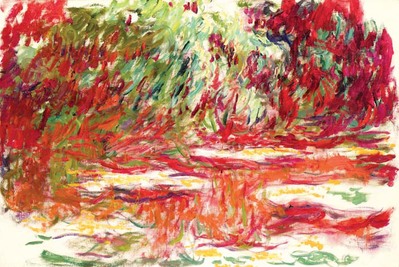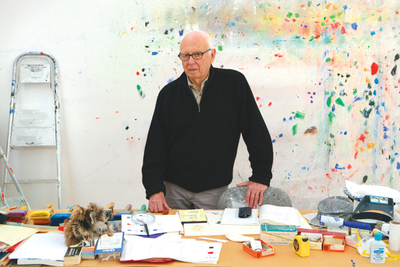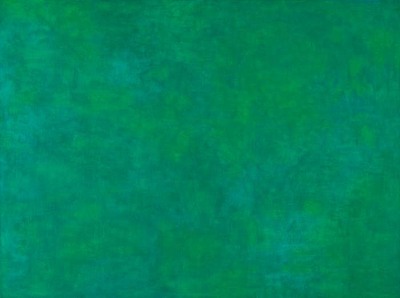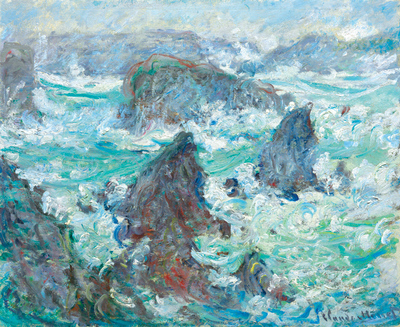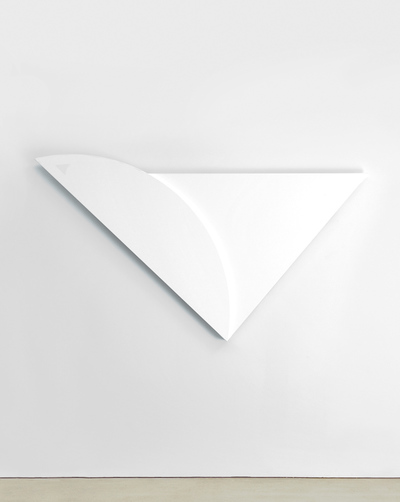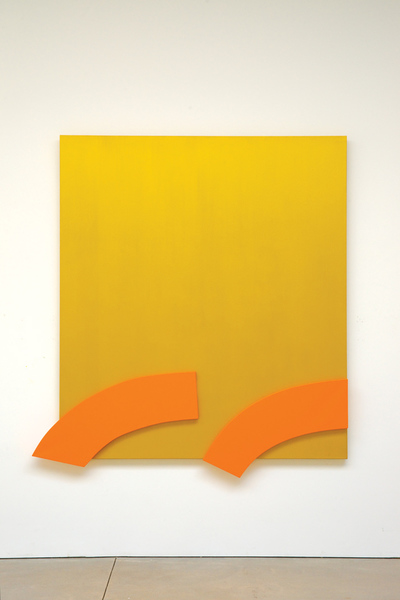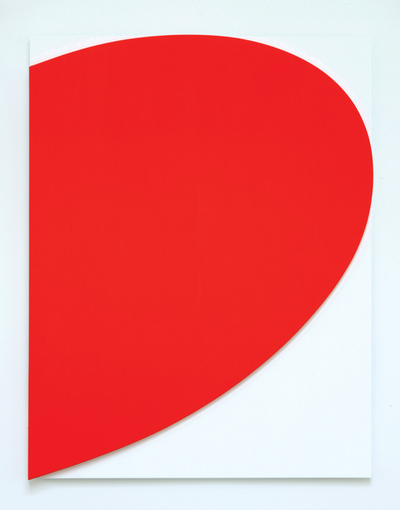Ellsworth Kelly Looks at Monet
Top: Claude Monet, The Water-Lily Pond, c. 1918–19, oil on canvas, 28 ¾ x 41 3/8″. Musée Marmottan Monet, Paris, 5105. Bottom: Portrait of Ellsworth Kelly in his Spencertown, NY, studio. Photo: Jack Shear.
Impressionist Claude Monet and hard-edge painter Ellsworth Kelly make an odd couple. One pursued a self-expressive, painterly style; the other, a cool detachment through fields of solid color. They could not be more unalike.
Yet the two are finding common ground in an exhibition selected and designed by Kelly himself at the Clark Art Institute in Williamstown, MA. Monet/Kelly looks at a moment early in Kelly’s career when he saw Monet’s late water lily murals for the first time and got a visual jolt.
“I had never seen painting like this,” he says in his catalog essay about his visit to Monet’s Giverny studio in August 1952. “[They were] overall compositions of thickly applied oil paint representing water with lilies, with no skyline. I felt that these works were beautiful, impersonal statements.”
Monet might argue with the descriptive “impersonal,” but those murals inspired Kelly to paint an homage the very next day—a monochrome of greens and blues suggesting grass underwater. He called it Tableau Vert.
“I had already made works with many color panels, but to make one color on a canvas was a challenge,” he said.
It was a disappointment.
“I thought it was a failure and didn’t look at it again until around 1985,” Kelly said years later. When he did, he found he liked it and gave it to the Art Institute of Chicago, which has loaned it for the Clark show.
Although Kelly, now 91, returned to painting fields of solid color, he said, “Monet’s paintings had a great influence on me, and even though my work doesn’t look like his, I feel I want the spirit to be the same.”
The Clark show grew out of his rethinking on the half dozen years he spent in France after his World War II army service as a camouflage engineer. He was studying at the School of the Museum of Fine Arts, Boston on the G.I. Bill, but grew bored with painting life models and left for Paris in 1948. There he took classes at the École des Beaux Arts; visited Romanesque churches, met artists such as Jean Arp, Constantin Brancusi, Alexander Calder and Alberto Giacometti; and exhibited in a number of group shows.
Disengaged from the abstract expressionist art scene flourishing in New York at that time, Kelly charted his own course, distilling fragments of what he observed—the frame of a window, patterns of light on a floor—into austere shapes, lines and colors.
“I like to look at things rather than what they mean,” he told me in an interview some years ago. Most people see with their minds rather than their eyes, he said. “I work hard at refining and keeping my eye engaged. I want the form to speak. I don’t want you to investigate the surface. I want you to read the form in relation to yourself.”
His deconstructions, his “compulsion,” as he put it, “about form and color,” made him a bridge between abstract expressionism and minimalism and among the pantheon of modern masters.
Kelly was well aware of Monet when he went back to Paris in 1948 at age 25, but said, “My knowledge of Monet’s work ended with the ‘Haystacks’ and I knew nothing of his work after 1900.”
Top: Ellsworth Kelly, Tableau Vert, 1952, oil on wood, 29¼ x 39¼”. © Ellsworth Kelly. Bottom: Claude Monet, Storm on the Coast of Belle-Île, 1886, oil on canvas, 23 1/2 x 28 1/2″. Private collection.
It was work even the French art world had yet to appreciate. Much of what Monet did in Giverny after 1900 was personal and experimental. Already famous, he could afford to do what he wanted. That meant returning again and again to the water garden he created there and painting it with ever-looser brushwork, undefined pictorial space and more vivid color—the last attributed in part to cataracts affecting his color perception.
Kelly had seen one of Monet’s water lily paintings in Zurich in May 1952, discovered he had a studio in Giverny, and asked his stepson, Jean-Pierre Hoschedé, if he could visit.
After seeing earlier canvases inside the house, he asked about work done after 1900. Hoschedé led him to the studio.
“I remember there were a couple of broken glass panes, some pigeons flying around and a lot of leaves on the floor,” Kelly said in his essay. “And there they all were. There must have been 15 enormous paintings, 20 feet long. I was very impressed.”
His confrontation with these late canvases, so different from his own, gave him, “a sense of bewilderment whose force led him to swerve for a very brief moment from his trajectory,” says art historian Yve-Alain Bois, who has known Kelly for years and collaborated on the exhibition. Bois said the shock allowed Kelly, to emulate Monet “at a fundamental level while dodging any anxiety of influence.”
The Clark show features six Giverny canvases, plus three Monet did at Belle-Île, an island off the southern coast of Brittany, where he spent four months in 1886. Monet died in 1926.
Kelly, too, visited Belle-Île, living in a fisherman’s cottage during the summer of 1949, with subsequent visits in 1965 and 2005. Among the 18 drawings he chose for the Clark show—none of them published until now—13 are from Belle Île. An oil canvas done much later was renamed White Curve in Relief over White (Belle-Île) in 2013.
Clark Senior Curator Richard Rand, who led the collaboration, said linking Monet and Kelly “demonstrates a continuity in the trajectory of modern painting. It contemporizes the historical by looking at older art with contemporary eyes,” he said. “At the same time, it historicizes the contemporary by linking it to a tradition.”
Top: Ellsworth Kelly, White Curve in Relief over White (Belle-Île), 2013, oil on canvas, two joined panels, 47¼ x 84″. Collection of the artist. © Ellsworth Kelly. Photo: Jerry L. Thompson. Middle: Ellsworth Kelly, Gold with Orange Reliefs, 2013, oil on canvas and wood, three joined panels, 79¼ x 72¾ x 2 5/8″. Courtesy of the artist. © Ellsworth Kelly. Photo: Jerry L. Thompson. Bottom: Ellsworth Kelly, Red Curve on White, 2011, oil on canvas, two joined panels, 70 x 54¼ x 2¾”. Photo courtesy of the artist.
While Monet’s anticipation of the abstract expressionism exemplified by Jackson Pollock and Willem de Kooning, has already been examined, notably in Monet in the Twentieth Century at the Museum of Fine Arts, Boston, in 1998, his connection with Kelly has gotten scant attention. The Clark show is a big step in filling that gap.
This is the second exhibition Kelly organized in Massachusetts in the past year. He also paired a selection of his own drawings with 45 by Henri Matisse in a fall show at the Mount Holyoke College Art Museum. In it, his elegantly spontaneous botanical drawings easily hold their own against Matisse’s wonderfully spare, patterned figure and interior images.
“Plant drawings are studies to keep the hand in good shape,” Kelly has said. “If I let up for a while, I get rusty.”
He credits his drawing skills to expressionist Karl Zerbe, one of his teachers at the School of the Museum of Fine Arts, Boston. “He could teach you how to see. It was about seeing and…owning…possessing what you are looking at.”
While studying in Boston from 1946-48, Kelly also taught art at the Norfolk House Center in Roxbury and exhibited in his first group show at the Boris Mirski Gallery.
Today, he lives with his partner, photographer Jack Shear, a stone’s throw from the Clark in rural Spencertown, NY, where he settled in 1970 to escape the rush of New York City.
Kelly still works regularly in a big white studio space described by one visitor as “very minimalist, quiet and contemplative.”
Slowed by an oxygen tube he wears, the result, it’s said, of years inhaling turpentine fumes, Kelly says that aging has its advantages.
“You see more,” he was quoted last summer as saying. “Every day I’m continuing to see things.”
Charles Bonenti is an art critic for The Berkshire Eagle, lives in Williamstown, and is a regular contributor to Art New England.

